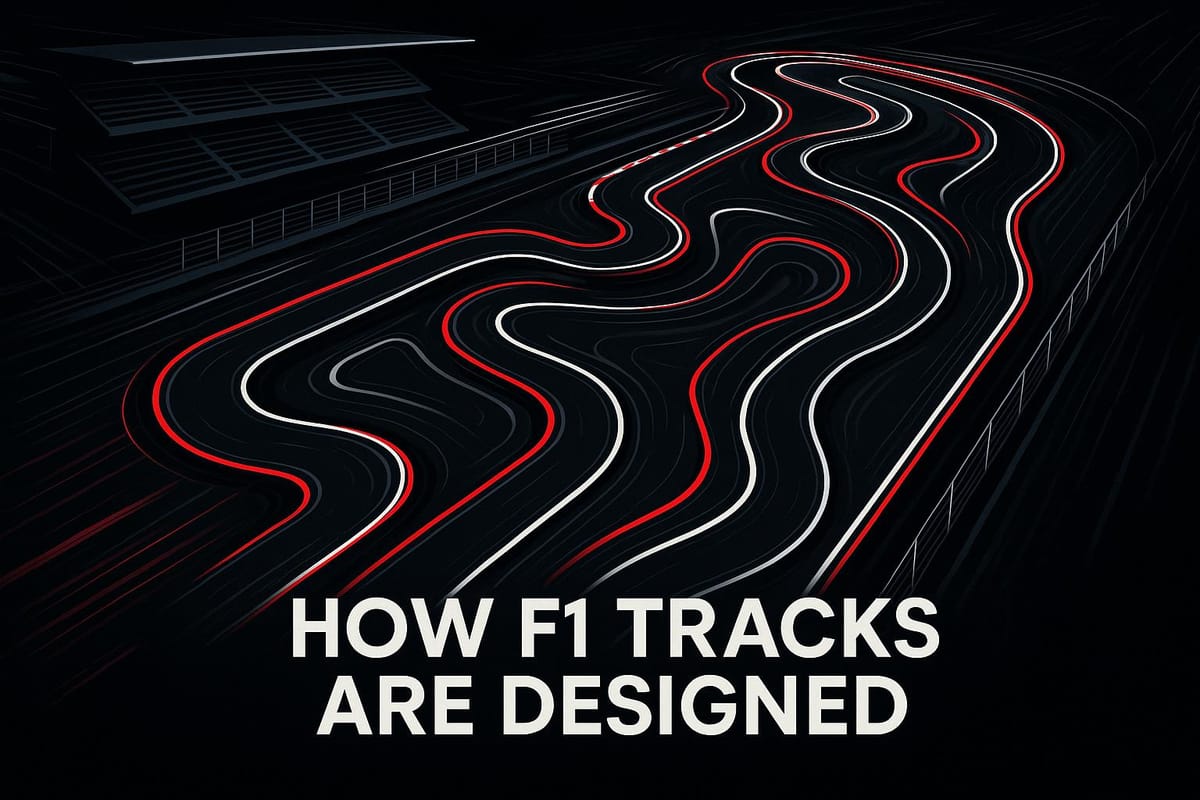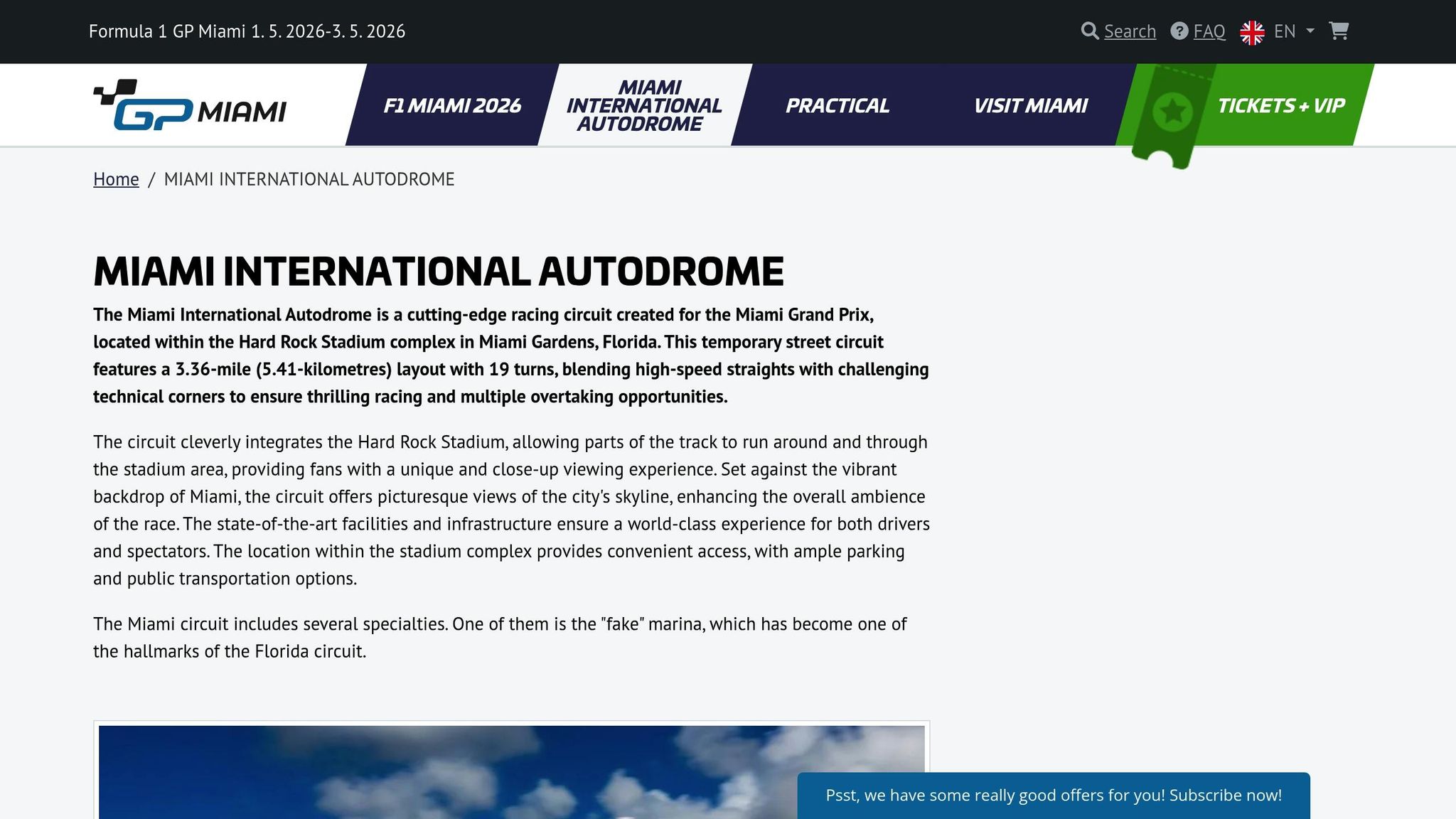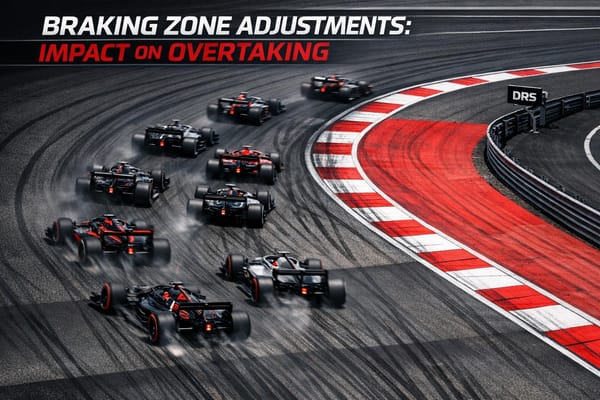How F1 Tracks are Designed: The Art and Science Behind the Curves
Explore the intricate blend of engineering and creativity that shapes Formula 1 track design, ensuring safety and thrilling racing experiences.

F1 track design is a blend of precision engineering and creative layout planning. Every circuit is crafted to test driver skill, ensure safety, and reflect the location’s natural features. Here’s what goes into it:
- Safety First: Tracks must meet strict FIA standards, including specific lengths (2.17–4.97 miles), widths (39+ feet), advanced barriers, and run-off areas.
- Driver Challenge: Corner sequences, straights, and elevation changes are designed to push cars and drivers to their limits while encouraging overtaking.
- Location Matters: Geography, terrain, and accessibility shape the circuit’s layout and character.
Modern circuits like Yas Marina and Circuit of the Americas combine tight corners, fast straights, and unique terrain to create thrilling race experiences. The process involves simulations, precise construction, and attention to surface durability. Iconic tracks like Monaco, Suzuka, and Miami highlight how design choices influence both racing and logistics.
F1 track design is a meticulous process that balances safety, technical challenges, and the spectacle of racing.
How to Design the Perfect F1 Track
Core Principles of F1 Track Design
Designing an F1 track is no small feat. It revolves around three key principles: safety, driver challenge, and location. These elements come together to create circuits that balance technical precision with the thrill of racing.
Meeting FIA Safety Requirements

At the heart of F1 track design is the FIA Grade 1 license, which sets rigorous safety standards that every circuit must meet to host F1 races. These regulations influence everything from track dimensions to barrier systems.
An F1 circuit must measure between 2.17 miles (3.5 km) and 4.35 miles (7 km) in length, with a consistent width of at least 39 feet (12 meters). The starting grid area requires even more space, widening to 49 feet (15 meters) and spacing grid positions 26 feet (8 meters) apart - far more than the 20 feet (6 meters) needed for other racing circuits.
Modern safety measures have come a long way. Gone are the days of gravel traps and concrete walls dominating track perimeters. Today, circuits feature run-off areas and advanced safety systems like Tecpro barriers and tire walls, which absorb impacts more effectively. Medical facilities are also strategically placed around the track to ensure rapid response in case of accidents.
Special attention is paid to the first corner, a critical point for both safety and racing dynamics. Regulations require at least a 45-degree change in direction with a radius under 984 feet (300 meters). Even advertising around the track is tightly controlled to avoid obstructing visibility or creating visual distractions for drivers. Regular inspections by the FIA ensure that circuits maintain these high standards, with the risk of losing Grade 1 status if they fall short.
Creating Driver Challenge and Racing Action
The best F1 circuits are those that test driver skill while fostering competitive racing. Achieving this balance requires a deep understanding of track geometry and how it impacts both driving style and car performance.
Track designers often focus on corner sequences that reward different approaches. Clive Bowen, a leading expert in circuit design, highlights three strategies to encourage overtaking: placing short apexes before long straights, engineering grip into specific corners, and using compound radii to allow for late apexes.
"research and liaison with teams and drivers has genuinely achieved good results in his projects and he believes that the secret is to design the track geometry 'to build in' confidence and grip for drivers just where they need it the most to make a pass."
Corner sequences also play a crucial role in defining a track's personality. Thoughtfully designed sequences create opportunities for diverse car setups and racing strategies, ensuring no single approach dominates.
"I suspect it is the subtlety of a track's corner sequencing and detail which affects its personality and this in recent times has been lost because of modern design processes."
Take the upcoming Madrid circuit as an example. Its 3.36-mile (5.407 km) layout features 22 corners and a banked curve that allows speeds of up to 211 mph (340 km/h). This mix of technical sections and high-speed elements showcases the modern philosophy of track design.
Using Natural Terrain and Location
A track’s location and terrain are as important as its technical features. The best circuits use the natural landscape to create a unique identity, blending aesthetic appeal with racing challenges.
Elevation changes, for instance, add complexity by requiring precise braking and throttle control. Natural features like forests, lakes, or rivers can enhance the visual and technical aspects of a circuit, while the terrain’s natural contours often shape the track layout.
Practical considerations also play a role. Designers must ensure the location supports the logistical demands of an F1 weekend, from nearby airports to hotels and transportation networks. By balancing these practical needs with creative opportunities, designers turn geographic constraints into defining features that give each circuit its own character. The result? Tracks that not only meet FIA standards but also reflect the essence of their surroundings.
The Track Design Process: From Concept to Completion
Turning an F1 track from an initial idea into a race-ready circuit is a massive undertaking. It takes years of planning, hundreds of millions of dollars, and a blend of cutting-edge technology, engineering brilliance, and meticulous project management. The journey - from digital blueprints to on-site construction - showcases the perfect marriage of creative design and engineering precision.
Simulations and Modeling: Shaping the Perfect Layout
Before a single shovel hits the ground, F1 track designs are rigorously tested using advanced simulation software. These digital tools help designers fine-tune every detail, from corner angles and elevation changes to track width and safety zones. This level of precision ensures that the final layout not only meets F1's strict standards but also delivers an exciting racing experience.
Simulations aren’t just for cars - they’re integral to track development. For instance, Oracle Red Bull Racing relies on Ansys Fluent CFD for virtual wind tunnel simulations, while Honda Racing Corp. uses Ansys Cloud Direct to run detailed fluid dynamics tests. These tools allow designers to push creative boundaries while ensuring safety and performance. Programs like CSAS are tailored specifically for F1, analyzing critical factors like runoff areas and crash barrier placement. Once the digital layout is perfected, engineers shift their focus to the materials that will bring the design to life.
Engineering the Perfect Surface
The track surface is arguably one of the most crucial elements of an F1 circuit. It’s not just about laying asphalt - it’s about creating a surface that can handle the extreme forces of F1 cars while maintaining consistent grip and durability. For example, the Las Vegas Grand Prix required extensive street paving to ensure the surface met these rigorous demands.
Grip consistency is key. F1 cars generate immense downforce and braking forces, which can quickly wear down poorly constructed surfaces. The asphalt must maintain its performance across an entire race weekend, no matter the weather. Whether under scorching heat or heavy rain, the track must deliver. To handle sudden downpours, circuits include advanced drainage systems that prevent water buildup while protecting the track’s structural integrity.
Overcoming Construction Challenges
Building an F1 circuit is no small feat, especially in urban areas where the track must coexist with existing infrastructure. The Las Vegas Grand Prix is a prime example. Turning the iconic Strip into a 3.8-mile racetrack required innovative solutions to keep the city running smoothly. For instance, three temporary bridges were installed to maintain access to 23,000 hotel rooms, and close coordination with resorts ensured minimal disruption.
The PENTA Building Group tackled these challenges using advanced tools like Autodesk Construction Cloud. This platform, which includes Autodesk Build and Autodesk BIM Collaborate, allowed the team to manage intricate details and stakeholder coordination, completing the project in just 11.5 months.
"Autodesk Construction Cloud has been a tremendous tool to help us to collaborate with our trade and design partners in one environment", said Cliff Cole, Director of Virtual Design and Construction at The PENTA Building Group.
For temporary circuits like Miami, digital asset management has streamlined construction. Apex Circuit Design uses ApexBUILD, a digital twin tool, to oversee the setup and removal of over 7,000 components, including 2,900 Geobrugg concrete barriers and debris fencing. Each piece is tagged with a QR code for real-time tracking.
The financial scale of these projects is staggering. The Paddock Building for the Las Vegas Grand Prix alone cost an estimated $480 million, making it the largest F1 facility in North America.
"We are holding an event that's never been done before... To bring an event of this magnitude and shut down the roadways at the same time; there's just no playbook for this", said Renee Wilm, chief legal and administrative officer of Liberty Media and CEO of Las Vegas Grand Prix.
From rigorous simulations to innovative construction techniques, every step in the process is designed to overcome challenges and deliver a world-class racing experience. And the investment pays off - research projects that the Las Vegas Grand Prix will generate $1.2 billion for the local economy in its first year alone.
F1 Track Components: Key Features Explained
Every Formula 1 circuit is a masterpiece of design, blending various elements that shape not only its physical layout but also the strategies teams employ and the challenges drivers face on every lap.
Curves, Straights, and Chicanes
An F1 track’s character is largely defined by the interplay of its corners, straights, and chicanes. These features create the rhythm of the race, testing the limits of both cars and drivers. For example, tight corners like those at Circuit de Monaco demand cars to prioritize agility over outright speed, where even the smallest mistake can have major consequences. At the Circuit of the Americas in Texas, drivers encounter a mix of hairpins, sweeping curves, and long straights, each requiring a different approach behind the wheel.
Chicanes, on the other hand, serve a dual purpose. They break up long straights to manage top speeds for safety while setting up overtaking opportunities, adding a layer of strategy to the race. Meanwhile, the length and gradient of straights force teams to strike a balance between downforce for cornering and reduced drag for higher speeds.
Elevation Changes
Adding elevation changes to a circuit transforms it from a flat track into a dynamic, three-dimensional challenge. Tracks like Circuit de Spa-Francorchamps are famous for their dramatic uphill climbs, steep downhill descents, and flowing turns that push both drivers and cars to their limits.
Uphill sections test a car’s power delivery and aerodynamic stability as drivers work to maintain traction. Conversely, downhill stretches require precision braking to handle the momentum as cars approach corners at higher speeds. These elevation shifts not only add excitement but also demand a higher level of skill and adaptability from drivers.
Safety Zones and Features
Safety is a cornerstone of modern F1 track design, with features like run-off areas and advanced barrier systems playing a vital role in protecting drivers while preserving the thrill of racing. Take the Yas Marina Circuit in Abu Dhabi, designed by Hermann Tilke - it incorporates extensive safety measures seamlessly into its layout. These features ensure that while drivers push their limits, the risks are carefully managed, allowing the competition to remain intense without compromising safety.
Case Studies: Famous F1 Tracks and Their Design Features
These case studies provide a closer look at how some of the most iconic F1 tracks tackle unique challenges, showcasing diverse approaches to world-class circuit design.
Monaco Grand Prix: Urban Track Integration

Monaco is a shining example of how a street circuit can transform an urban landscape into a world-renowned motorsport venue. The streets of Monte Carlo become a 3.337 km (2.074 miles) racing circuit, demanding precision rather than outright speed.
What makes Monaco stand out is its dramatic elevation changes - 42 meters (138 feet) across the track - and its tight, winding layout. The Fairmont Hairpin, for instance, forces drivers to slow to just 48 km/h (30 mph). Nelson Piquet once famously described the challenge of Monaco by saying:
"Driving in Monaco is 'like riding a bicycle around your living room.'"
The logistical challenges are equally impressive. Temporary barriers and infrastructure are installed and dismantled with remarkable efficiency. Lewis Hamilton summed up the unpredictability of the circuit with his observation:
"Most often, it's just sheer luck. Throw it into the corner and come out with your eyes open. And hopefully you've made it round."
Suzuka Circuit: Elevation and Layout Complexity

Suzuka is a masterpiece of permanent track design, offering a unique figure-eight layout with both clockwise and counter-clockwise sections - the only one of its kind on the F1 calendar. This 5.807 km (3.608-mile) circuit combines flowing, technical challenges with a 40.4-meter (132.5-foot) elevation change and just 1.2 km (0.75 miles) of straight track.
The track’s technical sections push drivers and cars to their limits. The Esses require precision at speeds of around 245 km/h (152 mph), while the iconic 130R corner demands incredible skill, with cars hitting speeds of 300 km/h (186 mph) or more. These high-speed segments generate lateral G-forces up to 4G, making Suzuka a true test of endurance and engineering.
Miami International Autodrome: Modern Urban Track Design

Debuting in 2022, the Miami International Autodrome represents a modern approach to F1 track design. Set within the Hard Rock Stadium complex in Miami Gardens, this temporary circuit was designed to feel permanent while bringing motorsport excitement to an urban setting. Engineers tested 36 layouts before finalizing the 5.412 km (3.36-mile) track, which was completed in just over a year.
The circuit features 19 corners, three straights, and three DRS zones, allowing cars to hit speeds over 350 km/h (217 mph) with an average qualifying speed of 223 km/h (139 mph). The track surface is engineered for durability and grip, incorporating a high limestone content and a water jet blasting process to optimize performance. Elevation changes, particularly between Turns 13 and 16, add another layer of complexity.
Miami’s integration with the Hard Rock Stadium highlights how modern F1 tracks can utilize existing infrastructure. The venue, known for hosting Super Bowls, World Series games, and major concerts, demonstrates how motorsport can enhance urban spaces while delivering a unique fan experience.
These tracks, from Monaco’s historic streets to Miami’s modern innovation, showcase the remarkable diversity and creativity in F1 circuit design. Each presents its own set of challenges, pushing drivers, engineers, and organizers to their limits.
Conclusion: Combining Creativity, Precision, and Strategy
Designing an F1 track is a delicate dance between artistic imagination and engineering accuracy, resulting in circuits that test both drivers and their machines to the extreme. From the iconic streets of Monaco to the intricate figure-eight layout of Suzuka, each track tells its own story while staying true to the essence of Formula One.
Take Monaco, for example. Drivers crawl through the Fairmont Hairpin at just 48 km/h (30 mph) before rocketing through the tunnel at 260 km/h (162 mph). This dramatic shift in speed isn’t just a spectacle - it’s a deliberate challenge crafted by designers to test driver adaptability. On the other hand, Suzuka’s unique figure-eight layout, complete with a crossover bridge, pushes drivers to their limits by demanding mastery of every skill in their arsenal. These design intricacies aren’t just technical feats - they actively shape race strategies and outcomes.
Beyond the technical brilliance, strategic design choices play a pivotal role in the competition. Monaco, for instance, is a track where grid position and pit strategy often outweigh raw speed. Limited overtaking opportunities mean precision is everything. As Rob Widdows from Motor Sport puts it, the "Monaco challenge remains unique". Tracks like this set timeless benchmarks, proving that design philosophies can transcend eras.
Safety has also evolved into a cornerstone of modern track design. Decades of learning from past incidents have led to the integration of run-off areas, advanced barriers, and top-tier medical facilities. These innovations allow for bold and challenging layouts while ensuring the safety of drivers and fans alike.
Looking to the future, the lessons from legendary circuits like Monaco and Suzuka will continue to shape new designs. The balance of speed, technical complexity, and safety remains a guiding principle. Features like elevation changes and sections that reward driver skill are central to every new proposal, ensuring that the spirit of Formula One endures.
FAQs
How do F1 track designers create circuits that are both safe and thrilling for drivers and fans?
How F1 Tracks Balance Safety and Thrills
Designing an F1 track is a careful dance between precision and creativity. Every track layout is crafted to deliver a mix of high-speed straights, sharp turns, and dramatic elevation changes. These elements not only push drivers to their limits but also create heart-pounding moments that fans live for, like daring overtakes and edge-of-your-seat battles.
When it comes to safety, modern circuits leave no room for compromise. Wide runoff areas, advanced barrier systems, and clearly defined track limits are integrated into the design to minimize accidents without dulling the competitive edge. Everything from the angle of a corner to the width of the track is scrutinized to strike that perfect balance - keeping drivers secure while ensuring the race remains as electrifying as ever for spectators.
How does natural terrain influence the design and excitement of F1 circuits?
The Role of Natural Terrain in F1 Circuit Design
The natural landscape plays a huge part in shaping the design of Formula 1 circuits. Features like elevation changes, the layout of the track, and its overall flow are often dictated by the terrain. Steep climbs or sudden drops, for instance, not only push drivers to their limits but also bring an element of thrill and unpredictability to the races.
Track designers frequently use the land’s natural contours to craft circuits that feel both challenging and seamless. This method creates tracks that stand out, offering a unique racing experience for drivers while keeping spectators on the edge of their seats. Each circuit ends up with its own personality, adding variety and excitement to the F1 calendar.
What challenges arise when building F1 tracks in cities?
Building Formula 1 tracks in the heart of cities presents a distinct set of challenges. For starters, concerns about tree removal and heightened pollution levels can lead to legal battles and pushback from residents. On top of that, these projects must adhere to strict safety regulations, which can make the design and construction process even more complex.
Urban tracks also grapple with logistical obstacles, like working within tight spaces, modifying existing roads, and minimizing disturbances to daily city life. With costs often soaring past $270 million, meticulous planning and close coordination with local authorities are crucial to ensure the tracks meet safety requirements, function effectively, and address community concerns.
Related posts
- Imola’s Resurrection: From Tragedy to Triumph at the Emilia Romagna Grand Prix Circuit
- Albert Park Uncovered: The History, Evolution, and Challenges of the Australian Grand Prix Circuit
- Suzuka’s Legacy: How Japan’s Iconic Figure-8 Circuit Became a Driver Favourite
- Circuit of the Americas: The Best of the Best in One Track - A Deep Dive into COTA’s Design




